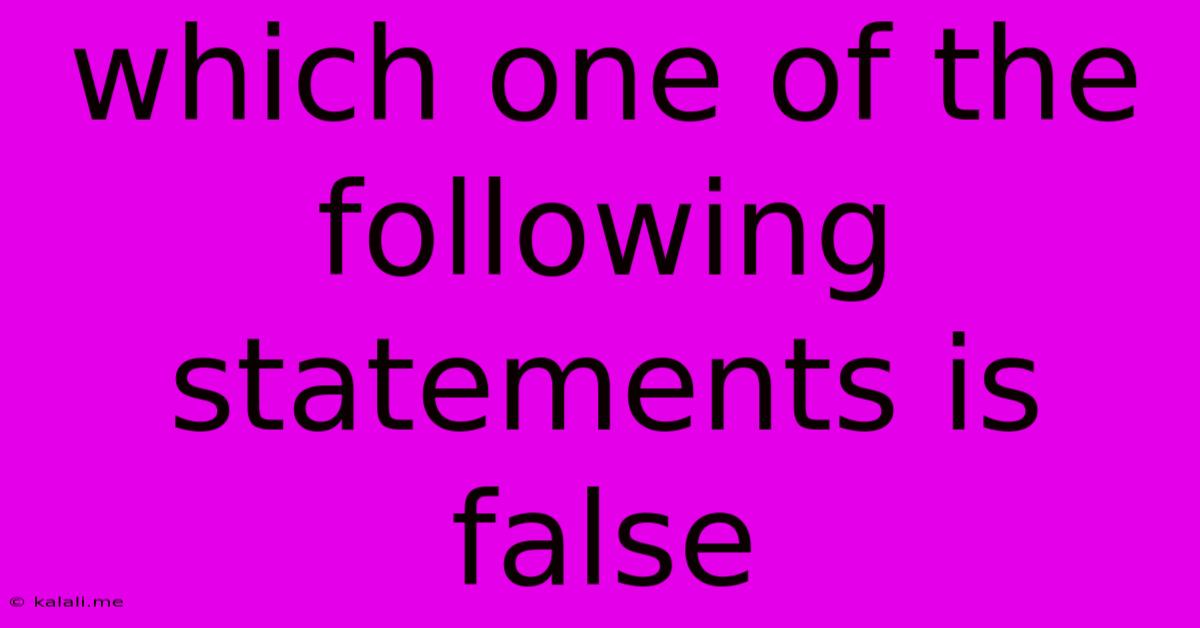Which One Of The Following Statements Is False
Kalali
Jun 12, 2025 · 3 min read

Table of Contents
Which One of the Following Statements is False? A Guide to Critical Thinking and Fact-Checking
This article explores the crucial skill of identifying false statements, a skill vital for navigating the modern information landscape saturated with misinformation and misleading content. We'll delve into strategies for evaluating claims, recognizing logical fallacies, and ultimately determining which statement from a given set is untrue. This is essential for academic success, informed decision-making, and responsible online engagement.
Understanding the Importance of Identifying Falsehoods
In today's world, where information spreads rapidly through various channels, the ability to discern truth from falsehood is more important than ever. False statements can be subtly misleading or blatantly inaccurate, and understanding how to identify them is crucial for:
- Avoiding Misinformation: Protecting yourself from believing and spreading inaccurate information.
- Critical Thinking: Developing the ability to analyze information objectively and form your own informed opinions.
- Effective Decision-Making: Making sound choices based on accurate and reliable data.
- Responsible Online Citizenship: Contributing to a more informed and trustworthy online environment.
Strategies for Identifying False Statements
Evaluating the truthfulness of a statement requires a systematic approach. Here are key strategies to employ:
1. Examine the Source's Credibility
Consider the reputation and authority of the source presenting the information. Is it a reputable news organization, a peer-reviewed academic journal, or a biased blog? A trustworthy source significantly increases the likelihood of accuracy. Look for evidence of fact-checking and transparency in their methodology.
2. Look for Evidence and Supporting Data
A credible statement will often be supported by evidence such as research studies, statistics, or verifiable facts. Lack of supporting evidence should raise a red flag. Be wary of statements based solely on anecdotal evidence or opinions.
3. Identify Logical Fallacies
Logical fallacies are flaws in reasoning that can lead to false conclusions. Common examples include:
- Appeal to Emotion: Manipulating emotions instead of presenting logical arguments.
- Straw Man Fallacy: Misrepresenting an opponent's argument to make it easier to attack.
- False Dilemma: Presenting only two options when more exist.
- Hasty Generalization: Drawing a broad conclusion from limited evidence.
- Correlation vs. Causation: Assuming that correlation between two things implies a causal relationship.
Understanding these fallacies helps you identify weaknesses in an argument and spot potential falsehoods.
4. Cross-Reference with Multiple Sources
Don't rely on a single source. Consult several reputable sources to verify the information. If multiple trustworthy sources corroborate the information, it's more likely to be true. Discrepancies between sources should trigger further investigation.
5. Consider the Context
The context in which a statement is made is crucial. A statement that may be true in one context could be false in another. Carefully consider the surrounding information and the overall narrative.
Example: Analyzing a Set of Statements
Let's say we have the following statements:
A. The Earth is flat. B. Water boils at 100 degrees Celsius at sea level. C. Gravity pulls objects towards the center of the Earth. D. The sun rises in the west.
By applying the strategies above:
- A is demonstrably false. Extensive scientific evidence proves the Earth is spherical.
- B is generally true, though slight variations can occur depending on atmospheric pressure.
- C is true. It's a fundamental principle of physics.
- D is false. The sun rises in the east.
In this example, statements A and D are false. The ability to distinguish these falsehoods relies on applying the strategies discussed.
Conclusion
Identifying false statements is a vital skill in the modern world. By developing critical thinking skills and employing the strategies outlined in this article, you can navigate the information landscape effectively, make informed decisions, and contribute to a more accurate and trustworthy flow of information. Remember that continuous learning and a healthy skepticism are essential for effectively discerning truth from falsehood.
Latest Posts
Latest Posts
-
Which Of The Following Is Not A Subatomic Particle
Jun 13, 2025
-
120 Sq Meters In Sq Feet
Jun 13, 2025
-
Which Of The Following Is A Secondary Pollutant
Jun 13, 2025
-
Which Of The Following Is Not A Function Of Fats
Jun 13, 2025
-
Which Is Not An Advantage Of Steel
Jun 13, 2025
Related Post
Thank you for visiting our website which covers about Which One Of The Following Statements Is False . We hope the information provided has been useful to you. Feel free to contact us if you have any questions or need further assistance. See you next time and don't miss to bookmark.